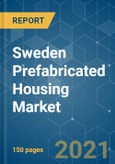Key Highlights
- The COVID-19 pandemic in 2020 plunged the global economy into recession and led to declines in prefabricated housing construction in Sweden, as lockdown measures and the need to adjust construction practices to accommodate greater social distancing stopped or slowed projects in the country. Rapid urbanization and the need to overcome housing shortages have provided market space for prefabricated structures.
- The market has some limitations, such as durability issues and a need for appropriate financing options for prefabricated living spaces. Sweden's prefabricated houses are mostly timber-framed, which means they are not radically different from most mid-grade structures design-wise. However, when it comes to production, the process is different from the current industry standard of crews erecting stick-built houses piece by piece. For production, measurements and specifications are planned by computer.
- The demand for low and medium-rise residential buildings, project housing, and public housing drives the market. About 84% of detached houses in Sweden use prefabricated timber elements. Prefabricated metal products are also used to meet modern architectural needs, where the structure of the building has decorative elements with unique shapes. Due to cost-effectiveness and time constraints, the construction sector has an increasing trend to use prefabricated components.
- In 2022, wooden skyscrapers witnessed significant growth in the country. In September 2022, a 20-story, 75-meter-high Sara Cultural Centre opened in the country. This project has six theater stages, a library, two art galleries, a conference center, and a 205-room hotel, and the project is built with 12,000 cubic meters of wood harvested from the nearby forest. This project is eco-friendly and caused significantly fewer carbon emissions during construction. Thus, the prefabricated sector is witnessing significant growth in Sweden.
Sweden Prefabricated Housing Market Trends
The Demand for Prefabricated Houses is Increasing in Sweden
- In 2021, Sweden was widely regarded as the leading country of offsite manufacturing, leading the world in terms of the sheer number of penalized single-dwelling residences, which represent over 80% of the country's overall housing market. Sweden has the world's highest percentage of factory-built wooden houses, mainly using closed wall panels. The trend is set to continue, with contemporary market stressors providing grist to the prefab mill.
- Sweden is undergoing a major building boom. With skills shortages in traditional construction trades placing further pressure on the sector, prefab houses are in high demand. Among the myriad influences that have led to Sweden's dominance of the offsite space in terms of skills, expertise, and industry structure, the most frequently cited factors are the country's abundance of slow-growing, premium-quality timber and its uniquely challenging climatic conditions.
- The increasing adoption of technology by prefabricated house developers is gaining traction among users. In 2022, energy-efficient housing solutions attracted Sweden's residential housing sector. In addition, manufacturers provided a two-story prefabricated residential building with an area of 150 square meters with solar panels. These modules are completely capable of providing themselves with electricity from solar panels. Meanwhile, the country has imported more than USD 360 million in prefabricated buildings to meet the increasing demand for modular housing units. Estonia, Latvia, China, Lithuania, etc., are some of the major exporters to the country.
Rise in Construction Activities
- Compared to many other countries, the Swedish government adopted a relaxed attitude in responding to COVID-19 and opposed a strict lockdown. Public health authorities recommended people to self-isolate and take preventive measures, but the results of this strategy were costly in terms of health.
- The performance of the Swedish construction industry is better than its European counterparts, largely due to the country's less stringent lockdown measures. Although the impact of COVID-19 was relatively limited, the outlook for the Swedish construction industry remains negative. Before the current crisis, the industry was already weak due to the economic downturn. After the pandemic, the government is preparing to rapidly advance its infrastructure spending plans. Although downside risks remain, especially if the outbreak worsens, Sweden's construction industry may perform better than most European neighbors.
- Meanwhile, the Swedish people are choosing wooden prefabricated housing over conventional houses, as they are time and cost-consuming. In addition, wooden structures, tar-coated timber houses, low-cost solar-powered houses, etc., are gaining traction among the public. In Q3 2022, building permits for various types of residential dwellings were significantly reduced. For instance, in Q3 2022, building permits for the construction of multi-dwelling buildings, excluding service dwellings, amounted to more than 6,560, which declined by nearly 40% compared to the same period in 2021.
Sweden Prefabricated Housing Industry Overview
Sweden's prefabricated housing market is highly competitive with none of the players occupying the major share. The market is fragmented, and it is expected to grow during the forecast period. Some suppliers are providing fully customized wooden prefabricated houses. Companies are implementing effective production technologies to minimize product costs and reduce related risks. Major players are Derome AB, Martinson Group AB, Lindbacks, and Trivselhus AB.Additional Benefits:
- The market estimate (ME) sheet in Excel format
- 3 months of analyst support
This product will be delivered within 2 business days.
Table of Contents
Companies Mentioned (Partial List)
A selection of companies mentioned in this report includes, but is not limited to:
- Peab AB
- Derome AB
- Martinson Group AB
- Lindbacks
- Trivselhus AB
- Gotenehus AB
- Alvsbyhus AB
- Anebyhusgruppen AB
- Eksjohus AB
- Vida AB








